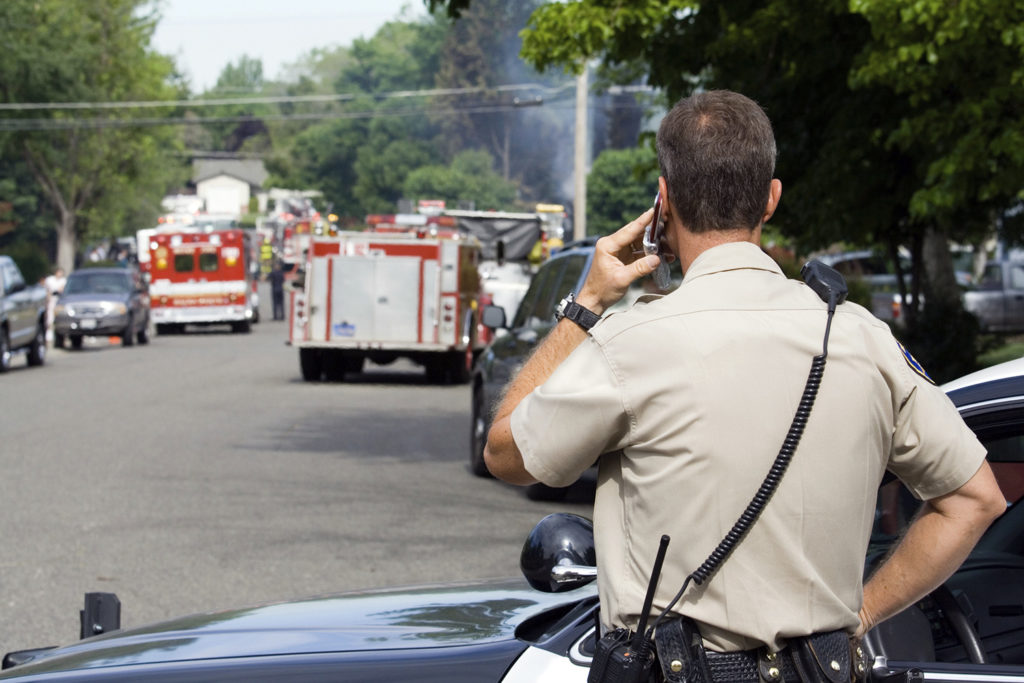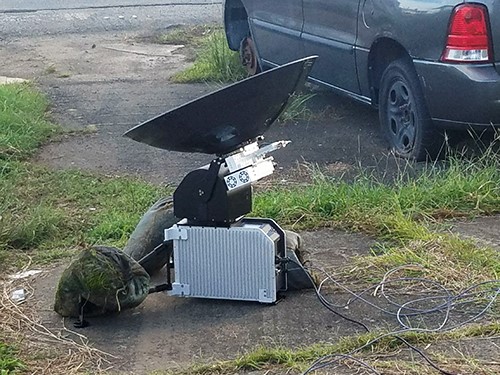Reliable Communication Key in Times of Disaster

By Kai Tang
Being connected is a given in our everyday lives, but at no time is it more critical than during or just after a natural disaster. When such an event strikes, first responders must be ready to deploy anywhere on earth, at a moment’s notice. For first responders and other public safety personnel, every second counts, and reliable connectivity is imperative to maintain seamless communication services.
However, reliability is dependent on the availability of your connectivity choices, and cell towers are often among the victims of natural disasters. Consider the devastation caused by Hurricanes Harvey, Irma and Maria, as well as earthquakes in Mexico, which hampered first responders in their ability to save lives and restore services. Hurricane Maria, in particular, had a catastrophic impact on Puerto Rico’s communications network.
The images from events such as these are a stark reminder that, as much as we consider cell phone coverage as ubiquitous, our reliance on it makes us vulnerable. During and after such an event, local terrestrial infrastructure and mobile phone networks are often overloaded, damaged or non-existent.
There continues to be a critical need for reliable satellite communication (SATCOM) services that are responsive to coverage needs and easy for first responders to operate. Imagine the following hypothetical scenario surrounding the rescue and relief efforts following a major natural disaster, one that is all too familiar to disaster response agencies, and only a small fraction for which they must prepare.
Disaster Strikes
A magnitude 8.2 earthquake has struck in a region, causing multiple casualties, wiping out power and infrastructure in several towns, and spreading panic about a possible tsunami threat. All communications in the area have been knocked out and the earthquake has caused massive structural damage and left several hundred stranded and vulnerable, with the lives of many in jeopardy.
First responders mobilize quickly. In situations like this when the alert is raised for urgent disaster relief and humanitarian assistance with no advanced notice, they must be prepared to get on a plane or a ship and go anywhere in the world to provide aid and relief in regions recovering from any one of a number of catastrophes. To do so, they must know that they have packed proven communications capabilities.
When they mobilize, communications are necessary and critical, but it is not the most important item that is competing for precious cargo space. Therefore, the best communication equipment must be small enough that you can quickly pack, travel with and set up literally in minutes, anywhere on the globe – a key “first in” capability during the first 24 hours on the scene.
No one knows in advance where or when the next disaster will occur. Responders often have less than 72 hours’ notice before moving into an unknown geographic location to work under extremely challenging conditions. Taking the time to arrange for shipping of gear means time taken away from focusing on the mission, so nothing beats the benefit of a small, highly portable terminal that can be quickly packed and is suited for travel.
Similarly, there is no substitute for a terminal that is easy to use—requiring little assembly, configuration, or expertise. When we as everyday users disembark and turn on our cell phones, the expectation is that the equipment will work. Period. For first responders, the moment they get off the plane and step into those challenging environments, they want to be confident in knowing their equipment will also work. The equipment must be easy to operate. The satellite service must be in place and ready to provide service. Network Operations Centers must be ready to support the sudden surge in network demand.
When All Else Fails
 Once deployed on the scene, first responders need instant SATCOM services in critically hit areas – regions where other communication options have failed or need time to set up. The first step in the successful coordination and management of a rescue and relief operation is often to establish a central base, where all information is gathered and distributed to all teams. This command and control center has a critical role in ensuring all teams on the ground receive the most up-to-date information to see where help is most urgently required.
Once deployed on the scene, first responders need instant SATCOM services in critically hit areas – regions where other communication options have failed or need time to set up. The first step in the successful coordination and management of a rescue and relief operation is often to establish a central base, where all information is gathered and distributed to all teams. This command and control center has a critical role in ensuring all teams on the ground receive the most up-to-date information to see where help is most urgently required.
Ground zero is usually utter chaos, as rescue workers begin assessing and addressing casualties. In times of critical need, emergency responders must focus on their mission. Watching a disaster unfold on a television news report is troubling, but to arrive at a devastated region in-person as a first responder? The emotions cannot be described. Not when victims are all around you who need medical attention, food, water and to find their loved ones. In providing relief, you want to focus on these victims, without worrying about whether you will be able to communicate and send video and data. First responders should not be expected to have a detailed mastery of how a communication system works. Assistance and relief is the mission, not communications set up, after all.
Therefore, it is imperative they have a reliable, always-on network that will allow them to focus on these critical priorities by providing SATCOM capabilities that require a minimum of installation for use – users are up and running within a few minutes. They do not need to undergo hours or even minutes of training or care about parts of the network. They need end-to-end system delivered by a single operator that enables global mobility and portability. A system that allows first responders to spend minimal time installing, troubleshooting and configuring, and all their time on the mission.
Bandwidth Where You Need it, When You Need it
With all communications needs being met, first responders can now focus on the casualties, especially those requiring immediate access to telemedicine. Thanks to the solid SATCOM infrastructure in place, medical experts are standing by connected via reliable voice and video to provide virtual assistance.
Ideally, those running the command and control center operations can dynamically allocate voice and data sources where most needed in real time. They are able to transfer live video streams from the affected areas back to the center so they can observe and advise. With surveillance aircraft circling the emergency zone with onboard cameras, that aircraft captures and transmits video and images back to rescue center, also in real time. This provides the command post the ability to build a bird’s eye view of what is happening on the ground and make decisions based on this information. A complete situation awareness capability such as this, enabled by SATCOM links, is vital in the success of any rescue operation.
In the hours following the earthquake, military teams are sometimes called in to assist with operations in the most critical areas. The Coast Guard is communicating with the surveillance aircraft, and back to HQ. Using Global Positioning System (GPS) location data, they are able to see where vessels have capsized to help their search and rescue operations. Because of the sheer scale of the event, traditional Ultra High Frequency (UHF) tactical satellite network is being significantly oversubscribed and is therefore limited. This lack of requisite bandwidth threatens the success of tactical operations and the overall mission. In order to work around this and more effectively coordinate the mission, innovative industry solutions deliver a highly resilient ‘UHF-like’ or Very High Frequency (VHF)-like tactical satellite capability to existing military radios through significant spectrum resources on its network. This enables disparate teams to have access to complementary L-band capacity that seamlessly augments UHF/VHF resources when the first-responder mission requires.
Those critical first 24 hours can stretch into a second, third, or even tenth day – possibly for weeks or longer. As the demand for bandwidth increases with the arrival of more relief teams and the need to support bandwidth-demanding communications, a wideband SATCOM network enables teams on the ground the ability to immediately use their 3G smartphones and tablets to help with the relief effort. High-speed data connections are established within minutes. This service is able to meet the diverse and expanding communication demands of all the relief teams, providing crucial voice and data connectivity to all on land, at sea, and in the air.
From the arrival of the first responders within hours of the crisis, up to days later, once the emergency response and relief mission expand, SATCOM has proven to be the only reliable and dependable communications, delivering “first in/last out” support while accessing immediate, easy-to-install and operate, anytime and anywhere connectivity – until the mission is completed.
Conclusion
This is just an example of one simple disaster communication scenario. But it is also a reality of how SATCOM networks serve as the critical communication capability: they must be interoperable and they must operate reliably in real-world disasters nationwide as well as globally.
Reliable communication networks are among governments’ greatest homeland security assets. They are essential for the critical information sharing needed among agencies to rapidly and effectively manage response and recovery efforts in the event of a worst-case scenario, such as manmade or natural disasters. Staying connected in the field is critical for homeland security officials, and the instant infrastructure that satellites provide during disasters is key.
Only SATCOM can provide a dependable platform that ensures first responders can stay in contact with each other and the outside world. SATCOM networks aid public safety organizations in their efforts to operate from minute one when a disaster strikes and through the weeks following, providing communication solutions that operate reliably around the globe. Throughout these unfortunate events, you can rely on SATCOM services that are responsive to coverage needs and easy for first responders to operate.
Sponsored content presented by Inmarsat Government
 Kai Tang is the chief commercial officer of Inmarsat Government Inc., a wholly-owned subsidiary of Inmarsat plc, and the world’s leading provider of global mobile satellite communications to the U.S. government.
Kai Tang is the chief commercial officer of Inmarsat Government Inc., a wholly-owned subsidiary of Inmarsat plc, and the world’s leading provider of global mobile satellite communications to the U.S. government.
To learn more contact Inmarsat Government.

